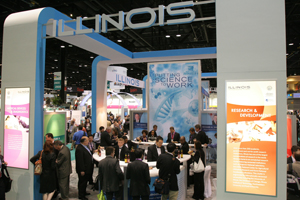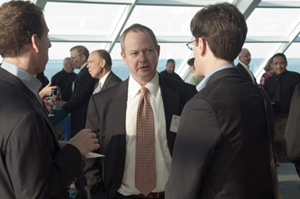Sell biology
The Chicago Innovation Pipeline bridges industry and academia, enhancing biotechnology research and bringing discoveries to market.
By Rob Mitchum
Photography by BIO and Lloyd DeGrane

The University's vision: science and business collaboration that spurs breakthroughs.
The term biotechnology implies a bridge, a connection between scientific discovery and its application to the broader world. But the link between two major components of that bridge—academic centers and private companies—is often tenuous, with different motivations, languages, and policies creating structural strain. Frequently, the struggle to bring a new biological innovation to market is not so much scientific as logistic, with financial and regulatory hurdles known in the biotech industry as "the valley of death."
At the 2010 BIO International Convention, held in May at Chicago's McCormick Place, the valley didn't feel quite as wide. As 15,000 participants presented, shopped, and discussed future applications of medical, agricultural, and energy discoveries, public-private partnerships were considered critical to the process.
Part of that optimism came from an unlikely source: the recent economic crisis, which may have pushed universities and corporations to come out of their silos and communicate. "There's a bunch of forces driving everybody to be much more collaborative," said Alan Thomas, director of UChicagoTech, the University's office of technology and intellectual property. "Everybody's got a piece of everybody else's puzzle."
Beneath the futuristic silver trusses of the Illinois booth on the bustling exhibit floor, the University introduced its contribution to that collaborative spirit. Called the Chicago Innovation Pipeline (CIP), the project is the result of regional teamwork, organized by Chicago with Northwestern University, Argonne National Laboratory, Children's Memorial Research Center, and the University of Illinois at Chicago. The goal: to help industry and academia join forces for biotechnology development.

UChicagoTech's Thomas sees a variety of forces pushing industry and academia together.
With promising research projects aggregated into what Thomas described as an iTunes-style database, CIP participants hope to make it easy for companies to quickly find drugs and devices they may be interested in using for partnerships. Douglass Given, PhD'79, MD'80, investment partner at Bay City Capital, applauded the effort at a University of Chicago alumni gathering at Adler Planetarium during the conference. "You've got the power of the way the University of Chicago thinks and acts in science," Given told the audience. "One of the great untapped opportunities is taking that and creating external relationships that take advantage."
Between the steady salesman hum of the exhibits and keynote speeches by former presidents George W. Bush and Bill Clinton, research sessions dug into the details of tomorrow's biotech breakthroughs. Panels of corporate and academic scientists—distinguishable by whether they wore a tailored suit or a rumpled polo—discussed futuristic solutions to medical problems. Some talked of building nanotech scaffolds to regenerate cartilage and spinal tissue. Another panel proposed an iPhone app that would combine a glucose monitor and an insulin pump to make an "artificial pancreas." Experts on skin-derived stem cells talked about a future where clinical trials with cells from thousands of subjects could be run in a laboratory dish.
While the majority envisioned transforming biology into technology, in the form of a new drug or diagnostic tool, the application of technology to biology was just as exciting. Rick Stevens, a Chicago professor of computer science, described the opportunities presented by dramatic improvements in computational power at centers such as Argonne. As the speed of sequencing complete genomes and modeling complex biological systems increases, Stevens said, the potential for running experiments entirely within the computer will revolutionize biology and medicine.
When the goal is curing disease, speed is good. That was the message at the convention's Translational Research Forum, cosponsored by Chicago, where speakers from research centers and patient advocacy groups argued that better partnerships and study design could shorten the path from lab to clinic. Julian Solway, director of U of C's Institute for Translational Medicine, said that public-health issues in the Medical Center's neighboring communities underscored the urgent need for new interventions. "It's in this context," Solway said, "that we seek to improve health by translating research discoveries into real and effective therapies."
The recurring theme, heard in practically every meeting room of McCormick Place: such improvements are better made with academia and industry standing together. Whether that camaraderie lingers beyond the annual BIO meeting or the economic crisis depends on keeping the bridges of biotechnology, communication in particular, strong. "There's much more of an open innovation environment now," Thomas said, "so speaking each other's language becomes much more important."
Return to top
